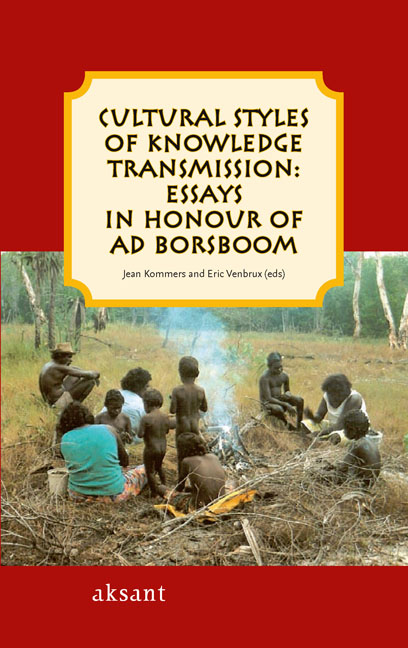Book contents
- Frontmatter
- Introduction
- Ad Borsboom
- Contents
- Maradjiri and Mamurrng: Ad Borsboom and Me
- Conversations with Mostapha: Learning about Islamic Law in a Bookshop in Rabat
- Education in Eighteenth Century Polynesia
- From Knowledge to Consciousness: Teachers, Teachings, and the Transmission of Healing
- When ‘Natives’ Use What Anthropologists Wrote: The Case of Dutch Rif Berbers
- The Experience of the Elders: Learning Ethnographic Fieldwork in the Netherlands
- On Hermeneutics, Ad’s Antennas and the Wholly Other
- Bontius in Batavia: Early Steps in Intercultural Communication
- Ceremonies of Learning and Status in Jordan
- Al Amien: A Modern Variant of an Age-Old Educational Institution
- Yolngu and Anthropological Learning Styles in Ritual Contexts
- Learning to Be White in Guadeloupe
- Learning from ‘the Other’, Writing about ‘the Other’
- Maori Styles of Teaching and Learning
- Tutorials as Integration into a Study Environment
- The Transmission of Kinship Knowledge
- Fieldwork in Manus, Papua New Guinea: On Change, Exchange and Anthropological Knowledge
- Bodily Learning: The Case of Pilgrimage by Foot to Santiago de Compostela
- Just Humming: The Consequence of the Decline of Learning Contexts among the Warlpiri
- A Note on Observation
- Fragments of Transmission of Kamoro Culture (South-West Coast, West Papua), Culled from Fieldnotes, 1952-1954
- Getting Answers May Take Some Time… The Kugaaruk (Pelly Bay) Workshop on the Transfer of Inuit Qaujimajatuqangit from Elders to Youths, June 20 - 27, 2004
- Conflict in the Classroom: Values and Educational Success
- The Teachings of Tokunupei
- Consulting the Old Lady
- A Chain of Transitional Rites: Teachings beyond Boundaries
- ‘That Tour Guide – Im Gotta Know Everything’: Tourism as a Stage for Teaching ‘Culture’ in Aboriginal Australia
- The Old Fashioned Funeral: Transmission of Cultural Knowledge
Fieldwork in Manus, Papua New Guinea: On Change, Exchange and Anthropological Knowledge
- Frontmatter
- Introduction
- Ad Borsboom
- Contents
- Maradjiri and Mamurrng: Ad Borsboom and Me
- Conversations with Mostapha: Learning about Islamic Law in a Bookshop in Rabat
- Education in Eighteenth Century Polynesia
- From Knowledge to Consciousness: Teachers, Teachings, and the Transmission of Healing
- When ‘Natives’ Use What Anthropologists Wrote: The Case of Dutch Rif Berbers
- The Experience of the Elders: Learning Ethnographic Fieldwork in the Netherlands
- On Hermeneutics, Ad’s Antennas and the Wholly Other
- Bontius in Batavia: Early Steps in Intercultural Communication
- Ceremonies of Learning and Status in Jordan
- Al Amien: A Modern Variant of an Age-Old Educational Institution
- Yolngu and Anthropological Learning Styles in Ritual Contexts
- Learning to Be White in Guadeloupe
- Learning from ‘the Other’, Writing about ‘the Other’
- Maori Styles of Teaching and Learning
- Tutorials as Integration into a Study Environment
- The Transmission of Kinship Knowledge
- Fieldwork in Manus, Papua New Guinea: On Change, Exchange and Anthropological Knowledge
- Bodily Learning: The Case of Pilgrimage by Foot to Santiago de Compostela
- Just Humming: The Consequence of the Decline of Learning Contexts among the Warlpiri
- A Note on Observation
- Fragments of Transmission of Kamoro Culture (South-West Coast, West Papua), Culled from Fieldnotes, 1952-1954
- Getting Answers May Take Some Time… The Kugaaruk (Pelly Bay) Workshop on the Transfer of Inuit Qaujimajatuqangit from Elders to Youths, June 20 - 27, 2004
- Conflict in the Classroom: Values and Educational Success
- The Teachings of Tokunupei
- Consulting the Old Lady
- A Chain of Transitional Rites: Teachings beyond Boundaries
- ‘That Tour Guide – Im Gotta Know Everything’: Tourism as a Stage for Teaching ‘Culture’ in Aboriginal Australia
- The Old Fashioned Funeral: Transmission of Cultural Knowledge
Summary
When I was about to leave the island of Baluan in 1988, after two years of fieldwork, the old woman Alup Nakeau gave me a special gift. It was large polished shell knife, called yanul, that according to traditional rules could be used only by lapans – that are traditional leaders – to cut and distribute a bunch of betelnut on ceremonial occasions (Ohnemus 1996). Alup Nakeau was then the oldest living member of the Sauka clan into which I had been adopted. She was the eldest child of Ninou Solok, who had been the last acknowledged lapan of the Sauka. The yanul not only connects me to Ninou Solok but through him also to an important event in the cultural history of the island.
In order to explain the importance of this event I have to sketch a little bit of the preceding cultural history of the island. Baluan is the birth place of Paliau Maloat, a political and religious reformer who has become very well-known in comparative studies of religious movements thanks to the work of Margaret Mead (especially 1956) and Theodore Schwartz (1962), see also Otto (1992a, 1998). After the Second World War, which had a great impact on Manus, Paliau succeeded in mobilising a large number of villages in a truly revolutionary reform movement. The overall aim of the movement was to become equal with the white colonisers. Paliau claimed to have received direct access to the same kind of knowledge that had made the white people so rich and powerful. He started to reorganise village life according to models he had learned while serving as a sergeant in the colonial constabulary. An important focus of his reform was the abolition of local traditions, which he thought were hampering progress. In particular the spectacular lapan feasts with the butchery of large numbers of pigs and the elaborate marriage ceremonies had to be discontinued because they were considered a waste of wealth and energy. This revolutionary restructuring had an enormous impact on social relations as local traditional leaders were deprived of one of their most important means of asserting their status.
Information
- Type
- Chapter
- Information
- Cultural Styles of Knowledge TransmissionEssays in Honour of Ad Borsboom, pp. 102 - 107Publisher: Amsterdam University PressPrint publication year: 2009
